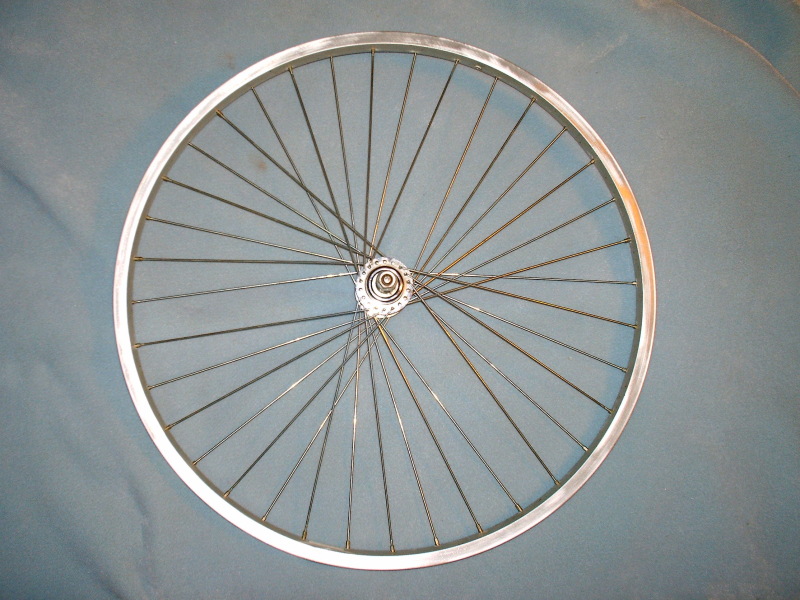closest I ever came to finite element analysis’ was using the add in on SolidWorks. I’m sure it’s pretty efficient when you know how to use it properly.
would be interesting to build wheels in SW and do an FEA on it.
Now you’ve got me thinking…I don’t have an Instron…but I do however have SolidWorks, and remember how to use Cosmos in it… are you thinking what I’m thinking B2? Oh wait, of course you are, seeing as you were the one that mentioned it!
if you built several lacing patterns in SW… from that you could theoretically create a program in excel that told you the strongest/most ideal lacing pattern depending on your hub/rim measurements right?
there’s a summer project for you.
Sounds like a plan Stan!!
I’ll have to organise to use one of the strain gauges at uni, and take a DT tensiometer, then I can record some pretty accurate results when I put it in SW.
I’ll say no more on this topic, this forum has a way of making people feel unwelcome at times.
I believe you Wheelworks, can’t argue with a engineer
This discussion went right over my head, but I do love the crows feet spoke pattern:

Don’t see enough of it IMO…
At the end of the day though, there is a reason why most wheels are built crossed and not radial right?
Isn’t that picture the 3 leading/3 trailing pattern? And yeah, I think it looks pretty cool!
And horatio, there’s probably a couple of reasons why your theory is true. It could be that in order to start producing radial front wheels, a compan (like Shimano) has to produce a radial-specific hub which is strong enough to take the force of the spoke (even though in both of those cases above the spoke was under 1300N of tension, the direction the spoke was pulling in the radial situation was such that it’s trying to pull right out of the hub) It would be expensive to have to make a ‘radial only’ front hub, as well as your normal front hub, but it doesn’t surprise me that high-end companies like DT Swiss offer this option.
It could also be for looks, and I know that sometimes, mass-produced wheels are built identical front/rear, even though sometimes they shouldn’t be. ie when one of them is meant to be laced asymmetrically, so they lace the other in the same way. Perhaps this comes down to ease of assembly, for it would be far quicker for a machine to produce two wheels of the same lacing pattern, rather than one of each.
I see a postgrad thesis on this in your future Brent*. That is if you have the goods to step up… 
*although I suspect it might already have been done
Ha, well, can’o’worms huh? Like Brent was saying, I thought 4x gave the wheels more give which is why I used it on BMX wheels (smaller and more spokes = stiffer to start with), but thought it might be too much for bigger wheels with less spokes and less of a beating.
I’m building them myself, I’m obviously no pro but they’ve turned out fine in the past, but bigger wheels probably mean small mistakes will make a bigger difference. I’ll see how it goes and it’s just used parts anyway (aside from the rear hub).
I’ll stick with 3 or 4.
Thanks for the help.
Reckon you’re right, there’s a lot out there, and I would imagine much more in Bicycling Science & published literature:
to http://www.sheldonbrown.com/rinard/wheel_index.html (Sadly, no test data for radial vs crossed lacing)
Aero Wheels Under Scrutiny, by François Grignon
http://opus.bath.ac.uk/1418/
http://www.duke.edu/~hpgavin/papers/HPGavin-Wheel-Paper.pdf
Tied and Soldered Wheels
My favourite part of Damon Rinard’s report:
Howard Sutherland is quoted as saying “One measurement is worth 50 expert opinions”
Pin20: That is indeed a 3 leading - 3 trailing, I’ve done that once, was a pain to true. Does look cool though.
Brent, love your response!
Don’t doubt your numbers, but consider the overall effect once you factor in (orders of magnitude greater) deflection of the tyre, fork/frame/stem/bar flex, I think the 10% Fx spoke contribution would barely be noticeable.
As quoted above, 1 real measurement of a pair of wheels will put this argument to bed faster than a well told lullaby. Perhaps you could lace up a pair of front track wheels radially & 3x and run the numbers? It’s very easy to use a dial gauge and a hung weight as Damon did to get some measurements, (or trade user Dafrog some beer for access to an Instron / Tinius Olsen.) If you get a good data set and write it up well, maybe you could even publish an article in Bicycle Quarterly (PM me if you want to borrow back issues, I think you’d enjoy it).